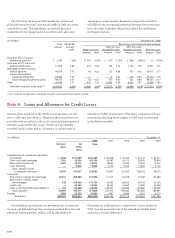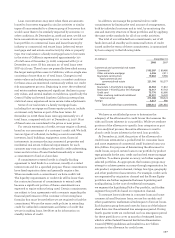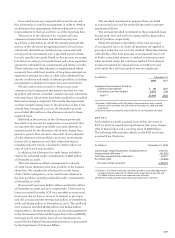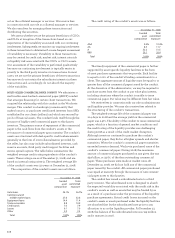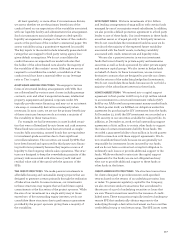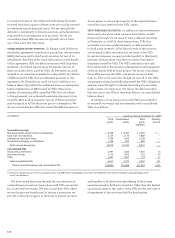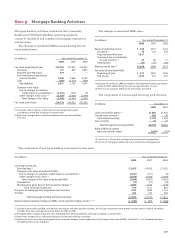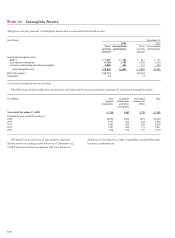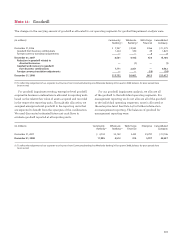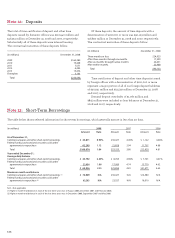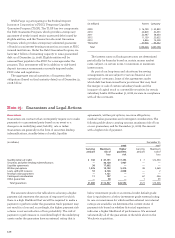Wells Fargo 2008 Annual Report Download - page 118
Download and view the complete annual report
Please find page 118 of the 2008 Wells Fargo annual report below. You can navigate through the pages in the report by either clicking on the pages listed below, or by using the keyword search tool below to find specific information within the annual report.
December 31, 2008
Funded Total
asset committed
composition exposure
Auto loans 34.1% 26.7%
Commercial and
middle market loans 27.6 32.6
Equipment loans 14.4 11.4
Trade receivables 8.8 10.9
Credit cards 7.0 7.9
Leases 6.1 7.0
Other 2.0 3.5
Total 100% 100%
act as the collateral manager or servicer. We receive fees
in connection with our role as collateral manager or servicer.
We also earn fees for arranging these transactions and
distributing the securities.
We assess whether we are the primary beneficiary of CDOs
and CLOs at inception of the transactions based on our
expectation of the variability associated with our continuing
involvement. Subsequently, we monitor our ongoing involvement
in these transactions to determine if a more frequent assessment
of variability is necessary. Variability in these transactions
may be created by credit risk, market risk, interest rate risk
or liquidity risk associated with the CDO’s or CLO’s assets.
Our assessment of the variability is performed qualitatively
because our continuing involvement is typically senior in
priority to the third party investors in transactions. In most
cases, we are not the primary beneficiary of these transactions
because we do not retain the subordinate interests in these
transactions and, accordingly, do not absorb the majority
of the variability.
MULTI-SELLER COMMERCIAL PAPER CONDUIT We administer a
multi-seller asset-backed commercial paper (ABCP) conduit
that arranges financing for certain client transactions. We
acquired the relationship with this conduit in the Wachovia
merger. This conduit is a bankruptcy remote entity that
makes loans to, or purchases certificated interests from SPEs
established by our clients (sellers) and which are secured by
pools of financial assets. The conduit funds itself through the
issuance of highly rated commercial paper to third party
investors. The primary source of repayment of the commercial
paper is the cash flows from the conduit’s assets or the
re-issuance of commercial paper upon maturity. The conduit’s
assets are structured with deal-specific credit enhancements
generally in the form of overcollateralization provided by
the seller, but also may include subordinated interests, cash
reserve accounts, third party credit support facilities and
excess spread capture. The table below summarizes the
weighted average credit rating equivalents of the conduit’s
assets. These ratings are as of December 31, 2008, and are
based on internal rating criteria. The weighted average life
of the conduit’s assets was 3.0 years at December 31, 2008.
The composition of the conduit’s assets was as follows:
The credit rating of the conduit’s assets was as follows:
December 31, 2008
Funded Total
asset committed
composition exposure
AAA 9.4% 10.4%
AA 8.3 11.7
A 52.2 51.5
BBB 30.1 26.4
Total 100% 100%
The timely repayment of the commercial paper is further
supported by asset-specific liquidity facilities in the form
of asset purchase agreements that we provide. Each facility
is equal to 102% of the conduit’s funding commitments to a
client. The aggregate amount of liquidity must be equal to or
greater than all the commercial paper issued by the conduit.
At the discretion of the administrator, we may be required to
purchase assets from the conduit at par value plus interest,
including situations where the conduit is unable to issue
commercial paper. Par value may be different from fair value.
We receive fees in connection with our role as administrator
and liquidity provider. We may also receive fees related to
the structuring of the conduit’s transactions.
The weighted-average life of the commercial paper was
12.4 days in 2008 and the average yield on the commercial
paper was 2.57%. The ability of the conduit to issue commercial
paper, which is a function of general market conditions and
the credit rating of the liquidity provider was challenging
during 2008 as a result of the credit market disruption.
Although investors continued to purchase the conduit’s
commercial paper, they did so at higher spreads and shorter
maturities. When the conduit’s commercial paper maturities
exceeded investor demand, Wachovia purchased some of the
conduit’s commercial paper. During 2008, the maximum
amount of commercial paper purchased on any given day was
$3.9 billion, or 33.6%, of the then outstanding commercial
paper. These purchases were made at market rates. At
December 31, 2008, we did not hold any of the commercial
paper issued by the conduit. All commercial paper purchased
was repaid at maturity through the issuance of new commer-
cial paper notes to third parties.
The conduit has issued a subordinated note to a third
party investor. The subordinated note is designed to absorb
the expected variability associated with the credit risk in the
conduit’s assets as well as assets that may be funded by us
as a result of a purchase under the provisions of the liquidity
purchase agreements. Actual credit losses incurred on the
conduit’s assets or assets purchased under the liquidity facilities
are absorbed first by the subordinated note prior to any
allocation to us as the liquidity provider. At December 31,
2008, the balance of the subordinated note was $13 million
and it matures in 2016.


